-
Posts
1,625 -
Joined
-
Last visited
Content Type
Profiles
Forums
Blogs
Gallery
Events
Store
Posts posted by NavyFCO
-
-
Page 7
The boat attacks were rebuffed but the night was ending and the gunboat returned to Gelendzhik. Here, the gunboat remained in the bay for the whole day without unloading, and attempts to disembark resumed the next night. However, the dense enemy fire made it impossible. Then the gunboat put out, radioed the boats, and trans-shipped the landing forces. The troops landed from the boats.
I landed opposite the military camp, breast ? deep in the water. It was so bright over the Tsemess bay as if it were the daytime. Enemy shells and missiles were exploding along the whole coastline. On the shore there were barbed wire and anti-personnel mines. We moved to the right along the coastline in the direction of the fish-factory berths, and then ? to Stanichka, where we engaged the enemy.
During the nights new units and task forces were landing and that allowed broadening the bridgehead. When the bridgehead was broadened, the Brigade was assigned a line of defense to the left of the 255th naval infantry brigade, which was its right side neighbor, and its left side neighbor was 176th naval infantry division.
Intense operations to fortify the line of defense had begun. In this respect we quite efficiently cooperated with the chief of the Brigade engineer service, Captain N.A. Isaev (Colonel N.A. Isaev died in 1973 in the city of Baku, where during his last years of military service he was an instructor at the Baku Military School). A separate chemical protection platoon and a separate combat engineer company covered all of the forward edge of the battle area with mine-and-flame field charges, consisting of anti-personnel mine and a case, filled with frangible grenades (Molotov cocktail). A separate flame thrower platoon, equipped with knapsack flame throwers, covered the area to the left of the cemetery where tank attacks were most likely. Later I deployed an ampolla thrower platoon to fortify that defense.
A platoon of the separate field charge and flame thrower company was later attached to the Brigade. I selected firing positions for that platoon at the junction with the 255th naval infantry brigade.
Page 8
That junction was making me anxious since it was located at the cemetery angle, which was closer to the sea, and the cemetery with all its monuments was a good natural cover for accumulating enemy soldiers as well as it was a convenient starting position to attack the junction. 2 ? 3 times a week I would walk along the Brigade forward edge by night and light it with signal flares to check for the explosions of mine-and-flame field charges - spontaneous or caused by the enemy fire.
Chemical protection training was organized at the Brigade units. At the separate infantry battalions it was conducted by the chiefs of the battalion chemical protection and chemical protection instructors of the companies; at the artillery and mortar battalions ? by chemical protection instructors, I held classes at the separate intelligence company. At the same time we were gathering and repairing abandoned chemical protection equipment; a shop was organized at the separate chemical protection platoon to repair gas masks. That allowed supplying the Brigade with protective equipment, which largely exceeded the organic quantities. Later, when the 18th Army chemical protection department officers inspected our Brigade chemical protection, they assumed that so much protection equipment was a result of capturing an enemy gas masks storage facility.
In March 1943 I was promoted to the next rank ? Senior Lieutenant and in April I was accepted as a candidate for joining the All ? Union Communist Party (of Bolsheviks).
After the April combats and the failure of the enemy operation, code-named 'Neptun', there were serious concerns that failing to break the heroic resistance of the Malaya Zemlia defenders with conventional weapons, the enemy would employ poisonous gasses. Those concerns were backed by the intelligence of the 18th Army HQ.
Page 9
Inspection of the chemical protection system in the units and task forces of the 18th Army landing troops showed that chemical protection was well organized in the 165th separate infantry brigade. The 18th Army issued an order to the troops on May 21, 1943, recognizing Brigade Commander Lieutenant Colonel Kliushnikov for the well-organized chemical protection of the troops and ordering to award me a governmental award. Later, being far from the Malaya Zemlia with the 218th infantry Division, I was informed by Major Beliaev, chief of the chemical protection service of the 20th assault infantry Corps that in accordance with the 18th Army order I was awarded the Order of the Red Star and later on I received the order itself. I still do not know if it resulted from the order on the status of the chemical protection system or if it was the award for the landing, given to all participants.
Due to the stabilization of situation on the Malaya Zemlia and in accordance with the decision made by the chain of command, the officers and HQs of the 165th and 51st separate infantry brigades were evacuated from the Malaya Zemlia, and the enlisted and NCOs as well as defense lines of the brigades were handed over to the 255th naval infantry brigade and the 107th separate infantry brigade. It happened in late May 1943.
Before the evacuation, Major Beliaev, the chief of the Corps chemical protection service-20, suggested that I take command of the chemical protection service of the 83rd naval infantry brigade. At the same time he said that he knew they would not let me leave the 18th Army anyway. Indeed, I had to withstand a very strong pressure of Colonel Bychkov, chief of the 18th Army chemical protection department, while being at Falshivyi Gelendzhik, where the 18th Army HQ was located at that time. He wanted me to stay as his assistant on operations and intelligence. I declined that proposal because I did not want to part with my combat friends at the 165th separate infantry brigade. Notwithstanding that we did not know at that time what lied ahead, I wanted to share their lot. Apparently, Colonel Bychkov could not act without my consent because we were being transferred to the reserve of the General Headquarters.
Page 10
Having overcome Colonel Bychkov's resistance, I left Gelendzhik together with the other officers, taking away some chemical protection equipment to train the future task force personnel that we were supposed to shape as well as Senior Sergeant Krut' as my supposed orderly. Later I recommended him to be commissioned and appointed him a chemical protection platoon leader at an infantry regiment of the 218th infantry division. At the Kabardin pass I learnt that my friend, Brigade engineer-165 Captain N.A. Isaev stayed with the 18th Army as the assistant chief of staff for the engineer troops. I was able to get in touch with him only in the 60's.
After a week's rest in Kuban' we arrived at the Steppe district in the vicinity of Rossosh. Command assignments for the 218th separate division and its units were made there. I was appointed chief of the division chemical protection service-218. Taking into consideration that all officers of the chemical protection service reported to me, all chiefs of the battalion chemical protection services of the 165th separate infantry brigade were appointed chiefs of chemical protection services of the regiments.
Personnel and equipment started coming in very quickly. Already in July 1943 the 218th separate division was fully raised and started operational training. In the beginning of August, the 47th Army (the 218th separate division was part of it) made a blistering march to the south and during the night on August 16 replaced the troops of the 40th Army at the southern wing of the Kursk Bulge. Here the victorious path of the division to the West began. The division was named 'Romodan' for liberating the Romodan railway junction and awarded the Order of the Red Banner.
In the beginning of September 1943 I was promoted to the next rank of Captain. In August I joined the All-Union Communist Party (of Bolsheviks).
On 22 September the division with its 667th infantry regiment (commander ? Major G.D. Rashutin, Hero of the Soviet Union for Dniper) approached the Dniper River to the south of the town of Kanev in the vicinity of the village of Sushki. Colonel Skliarov, Division commander, decided to cross the Dniper River without waiting for the rest of the units.
Page 11
He sent me to the regiment as his representative and Captain Poliakov represented the division HQ. Assisted by the local population during the night on 24 September we managed to secretly cross the Dniper River, move in the depth of the territory, held by the enemy, and capture a 105 mm gun battery. As it is now proved by the documents, ours was the first forced crossing of the Dniper.
The enemy energetically attempted to destroy the bridgehead that we had captured. While holding the bridgehead I suffered multiple fragmentary wounds, two of them were severe. The next day I also suffered gunshot wounds and I was evacuated to the medical battalion. The regiment commander Major G.D. Rashutin was taken there later. There we spent several days, being unfit for transportation. The Corps commander, Major ? General Abramov and Division commander, Colonel Skliadov visited us and told us that they had recommended G.D. Rashutin to be awarded a Hero award, and me - to be awarded the Order of Lenin (later I was awarded the Order of the Red Banner).
After some time we were sent to a field hospital. There G.D. Rashutin and I were lodged in different houses and we did not see each other again until the 60's.
I started changing hospitals and traveled as far as the towns of Semipalatinsk and Samarkand. In May 1944 I was discharged from the hospital with my wound still tender, carrying II category of disablement. All my attempts to continue with the military service failed and I was found unfit for military service.
In 1944 my father died in Samarkand, by that time being completely blind.
In two months following the discharge from hospital I began to work at the People's Commissariat for Internal Affaires of the Uzbek SSR. I worked with a stenographer since
Page 12
I still could not write at that time. In January 1945 I underwent one more operation on the nervous seam of the left elbow nerve. In April 1945 I moved home with my mother, to Odessa. I was absorbed into the intensive work to rebuild the national economy system, destroyed in the war; we were working for 16 ? 18 hours a day. At the same time I was completing my professional education, interrupted by the war, and in December 1949 I graduated from the chemical department of the Leningrad Industrial Institute (by correspondence). Since that time I have been doing research.
I married in 1951. My wife, Valentina Yakovlevna, is a teacher of English. In 1952 my son Dmitrii was born. Now he is a chemical engineer and works at an Odessa enterprise.
In 1954 the wound on my right arm closed up. In 1961 I defended my thesis and earned my Candidate of Technical Sciences Degree.
I am the author of several dozens of published scientific papers and several inventions.
(signed)
City of Odessa
01/27/79
0 -
Autobiography
My name is Steinberg Bentsion Shmulevich. I was born into the family of a clerk in the city of Odessa on 28 March 1922. My father, Dmitrii Bentsionovich, a former worker, used to be a food supply commissar and an executive secretary of the oil mills workers? trade union of southern Russia. When I was a child, he received on-the-job training and became the chief accountant and later ? the head of the planning department at a transport trust. My mother, Lidia Grigorievna, was a nurse. I have no brothers or sisters. In 1929 I entered #43 secondary school. Upon completion of the 7th grade I was moved to #121 secondary school. As a 5th or 6th grade student I became interested in physics and chemistry and established a home laboratory. In 1938 I joined the Komsomol. I took part in the Komsomol activities and was especially active in anti-religious propaganda as a Militant Atheists? Union member. Owning to my good knowledge of chemistry, I demonstrated spontaneous ignition of candles, transformation of water into wine, milk, etc. In 1939 I graduated from the secondary school with honors and the same year entered the Lomonosov Moscow Fine Chemistry Technology Institute. I lived at a hostel.
As an Institute student I was able to give the go-ahead to my scientific aspirations. Contacts with prominent scientists and well-equipped laboratories where I would spend all my spare time helped broaden my scientific views. But the war broke out in 1941. I immediately went to the Frunze District Military Registration Office of the city of Moscow and asked to be drafted.
Page 2
I was ordered to continue with my education. They said 'We will summon you, when we need you'!
I went to Frunze District Communist Youth Union Committee, where teams of volunteer Komsomol members were rumored to be organized. The same thing happened there. Then, together with the students of our Institute I traveled to construct Moscow defensive lines in Khotkovo (60 km from Moscow on Yaroslavl highway). There we were cutting an opening in the forest. Being physically well developed, I quickly mastered that work and in two weeks` time I received the highest (4th) category of the lumber ? man. I had two workmates (I was changing them because one would not manage to work for a long time) with whom I felled trees, and the team consisting of 18 people was lopping off the branches, cutting up the trunk into 6 meter pieces and moving them aside. There we worked until 1 August 1941.
On the 1 August classes at the Institute started and in several days me and a group of distinguished students (3rd ? 5th year), total of 17 people, were transferred to the Voroshylov Military Academy for Chemical Protection of the Workers' and Peasants' Red Army (now ? by name of Tymoshenko). A class was created based on our group and two more such groups (54 people). For some time we studied in Moscow, then ? in the camps, and then the Academy moved to Samarkand. We studied a lot, for 14 ? 16 hours daily. Hard study along with specialized selection of students made our graduation possible in the very beginning of March 1942. At the same time in front of the formation it was declared that our graduation class was the best since the Academy was established (in 1925). I was evaluated to be suitable for the billet of the chief of the chemical service of a division or of a separate infantry brigade. Truly speaking, together with high billets we were 'modestly' commissioned as '1st Lieutenants' because at that time
Page 3
the order of the Commander-in-chief was still valid and in accordance with it the first military rank could not have been higher.
Upon graduation from the Academy several other graduates and I were sent to the Transcaucasian Front. We traveled to Tbilisi through Krasnovodsk ? Baku. In Tbilisi we waited for several days for the chief of the Front chemical protection department to return from his trip. I was appointed instructor of chemical warfare at the newly created 2nd Baku Infantry School. My arrival at the school raised some interest among commanders and faculty members. It was due to the fact that I was the only 'academician' and in pre-war times it was very valuable. Besides, the 'academician' was not yet 20 years old ? I turned 20 in two weeks, when I was fully absorbed in instructing: nine hours a day, three three-hour lectures for the whole battalion in the open air. Such a workload resulted from the faculty being under-staffed.
I acted as an instructor at two battalions: the 1st and the 4th. On Sundays 60 km battle marches were held. The faculty members manned the control stations. Since the very beginning the teaching went well with me. Every 2 ? 3 weeks I was recognized for holding methodologically correct and well prepared lectures. As a rule other instructors were present at my lectures. I lodged not far from the school. But I wanted to take a direct part in the battles against the hateful enemy and every month I wrote reports, requesting to be posted with the front-line forces. Those reports did not have any consequences.
Page 4
By September 1942 the military and political situation worsened dramatically. German Fascists invaders moved to the Volga, Northern Caucasus in the vicinity of Mozdok, here and there they advanced as far as the reverse slopes of the Main Caucasus Ridge, their reconnaissance aircraft began to show up over Baku.
Deputy Front Commander for manning arrived in Baku to organize two separate infantry brigades ? the 164th and the 165th, on the basis of the three Baku infantry schools, an artillery brigade HQ and other units and groups, arriving in Baku. He demanded the school commandant to assign two officers to help him with his work. I was one of them. On learning that the position of the chemical protection service chief at the 165th separate infantry brigade was vacant, I submitted my personal record with an appropriate evaluation and was assigned to that position. The rest of the instructors took the bypass through Central Asia to go to Moscow under the command of the deputy People's Commissar, comrade Schadenko.
We embarked on a troop train and went to Sukhumi. On the way we received many apples, several cases per car. We threw apples into the oncoming troop trains carrying the wounded. We disembarked in Sukhumi. The city suffered air strikes before our arrival. Brigade units were sent to the Bzyb railway station: some went on foot, and the others took vehicles, as there was no railway from Bzyb to Sukhumi back then. At the Bzyb railway station we again embarked on a troop train to go to Tuapse. We took several convertible 12 - seat Fords from Baku. We placed one of them on an open platform and settled in it: brigade engineer Captain N.A. Isaev, deputy chief of staff for political affaires Battalion Comissair Solodovnichenko and I. A telephone line connected us to the front and the rear of the train.
Page 5
We disembarked in Tuapse and after dispersing the units went on vehicles and on foot on the road to Indiuk. In the area of a brick yard we established a battalion defense installation. In the same area I located a separate chemical protection platoon.
The rest of the units and the brigade HQ moved forward along the highway and then turned right into the canyon of the Skakykha River. It was in that canyon that the HQ temporary located at a mountain foot in a grove. It suffered a severe air strike there. It happened in the middle of the day just when they brought lunch. An aircraft singled me out as a target and dived several times to get me, but with no result.
In 1 ? 2 days the brigade HQ climbed the mountain and was accommodated in dugouts. A walking and a horse path were made through the canyon. But the horses died within a week because of the hard path and lack of fodder. Later we transported ammunition and food on donkeys but they also were dying in big numbers.
Brigade units organized defense on the neighboring hillocks. Our operations were local. The enemy did not press too much. In our turn, we also did not have enough troops for the decisive offensive operation and we did not receive such an order. Adverse mountain and forest environment hardened not only the combat operations but also our ammunition supply. The brigade suffered main losses during the first days, when it tried to force the enemy out of its dominating grounds without prior reconnaissance and sufficient training.
The 165th separate infantry brigade prevented the enemy from moving to Tuapse (it was stopped 16 km north ? west of Tuapse) by a stiff defense of its allocated lane, thus, upending the enemy's plans: had it reached Tuapse, the 12th, 18th, 47th, and 56th Armies would have been encircled, and the enemy would have received an opportunity to move further into
Page 6
Transcaucasus along the Old Suhumi highway.
From October to mid-December 1942, when fulfilling that mission, the 165th separate infantry brigade lost over a half of its strength. That is why during the third decade of December it handed its defensive lane over to a new mountain infantry division and was sent for re-manning into Sochi area, where its units took up their positions in the area from Novye Sochi to Staraya Matsesta. Already near Tuapse the brigade underwent qualitative changes: it ceased to be a cadet brigade because the reinforcement did not come from military schools, and the reinforcement, received in Sochi, did not include cadets either.
In Sochi Colonel P.F. Gornischenko, hero of the Sevastopol defense was appointed brigade commander. In late January the brigade was ordered to deploy to Tuapse and Gelendzhik. The Brigade HQ arrived at Gelendzhik. The units dispersed in a park not far from the berth. We learnt about the naval assaults in Yu. Ozereika and Stanichka. Units of the 255th naval infantry brigade and our separate machine gun battalion were sent to help the Kounikovtsi. Storm weather prevented the remainder of our brigade units from moving.
I remember going together with HQ officers to visit the senior naval commander, a Commander, whose plank shack was located to the left of the berth entrance, and request the departure. Two days went by. Then the brigade HQ, 2nd separate infantry battalion and other units embarked on a gunboat. At night we approached the burning coast but did not manage to disembark despite many attempts. German boats attacked the gunboat from the sea. The two gunboat canons (at the bow and the stern) were firing non-stop. The large number of troops on board was hampering the canon rotation. They were standing tightly. Shell fragments were hammering the deck and superstructure and there was nowhere to hide.
To be continued...
0 -
I purchased this huge group from a friend back in 2001. Only this past month as I was photographing the group did I discover that the biography of the officer was in the group! So, as I get things scanned (it's about 200 scans thus far) I'll start posting, but until then, enjoy his autobiography...
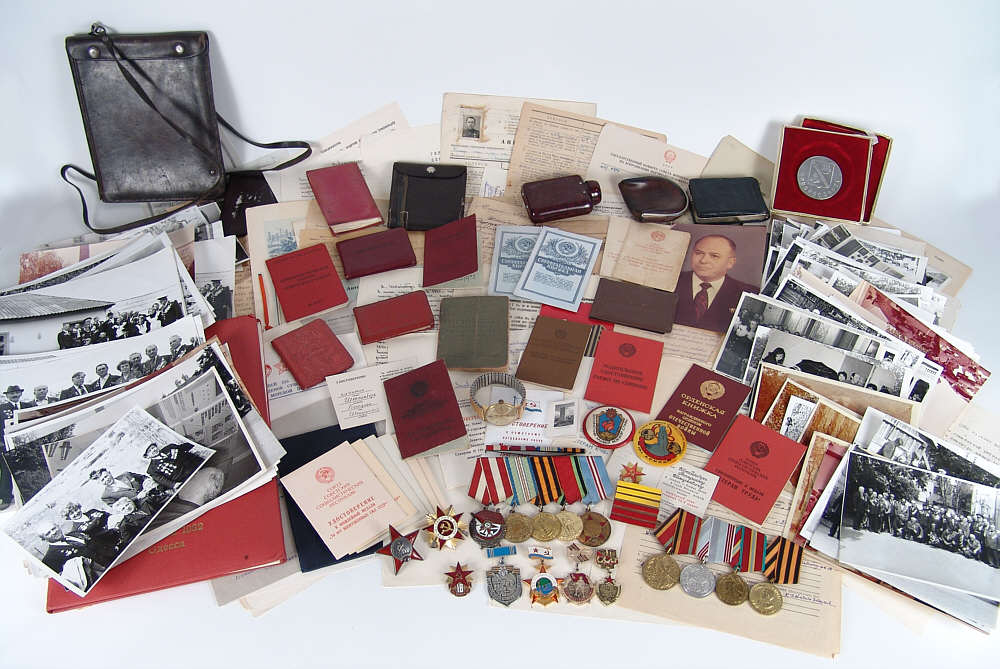
 0
0 -
I opened up the box on the left first, hoping to see the award. Of course, the Soviets HAD to send two boxes, one for the documents, and one for the award!
So, opening them up, we find.....
Yeah, BEAUTIFUL, just BEAUTIFUL!!! My breath is still gone from these... WOW
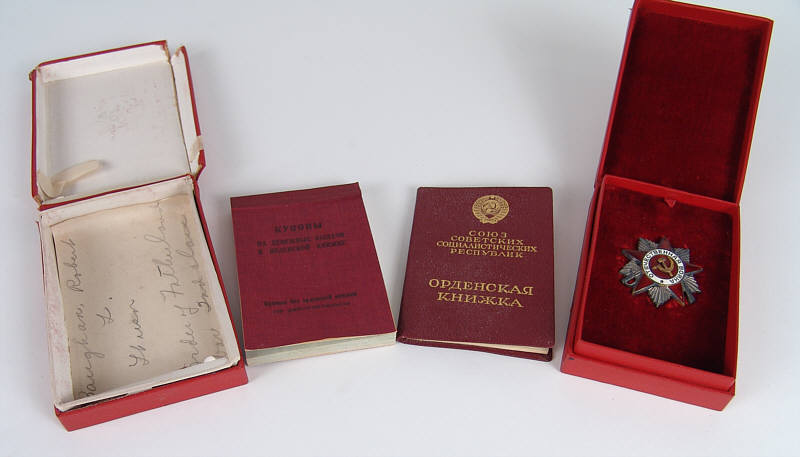
 0
0 -
Yeah, I know there's a thread about cased Soviet awards, but this was way too cool to have it buried on page three...
I got this in the mail today from the recipient. Unfortunately, it's just mine temporarily and then it has to be returned to the recipient, but for at least a short while, I can droooooooool.....


First, the boxes that came in the mail...
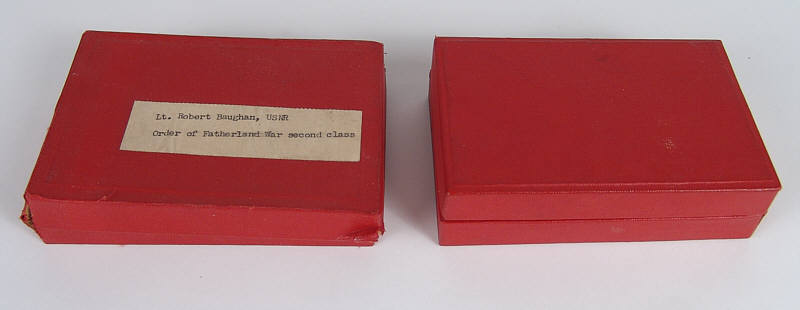
 0
0 -
I once had a chance to pick up several prisoner files from GULAG prisoners that were either executed or died in captivity. I only picked up one... a Jewish partisan who was blowing up Soviet equipment behind the lines and was captured (probably not the smartest move...) I think I kept some scans of it somewhere, and as I recall it had several letters like this in it. I wonder if, at the fall of the USSR, some of the local KGB archives were opened and the paperwork released?
Dave
0 -
And the US Navy has a sea service ribbon. To recognise sea service . . . by the navy . . . !! And the army give something for having seen dirt? (Maybe that is what the Service Ribbon is for?)
Actually, it's the "Sea Service Deployment Ribbon"... I've got three of them and they mean more to me than any other award that I have. In my opinion, this is one of the very few ribbons in the military that actually MEANS something... I've seen a lot of decorations given out for things questionable, and unit awards received by people onboard a unit for a single day within the period of eligibility. BUT, for the SSDR, you need to have spent at least 90 consecutive days away from homeport during a 12 month period assigned to an afloat unit. That's something that I think is pretty respectable.

Now, I do like your idea for the Army dirt ribbon....

As far as ribbons that we could do away with, I'm hip with getting rid of the Air Force and Army basic training ribbons, as well as the Army Service Ribbon. Being willing to sacrifice some myself, I think you could have the Navy's pistol/rifle marksman ones, and could also get rid of the Volunteer Service Medal (why do we wear a medal in uniform for things we do while not in uniform? I don't get it...) The Army could also get rid of the NCO course ribbons, the Air Force could get rid of their longevity ribbons, and combine their short and long deployment ribbons together for a single deployment one. Wouldn't we all be happier then???

Dave
0 -
Of what metal composition are the retaining nuts constructed of?
On a proper early WW2 badge (such as a sb ORB) everything (badge, screwpost and screw nut) should be silver.
Dave
0 -
Just remember though that many uniforms ended up in museums of all sizes in the former USSR, and many times awards were added at random - and over the years leaving marks like these.
What is odd though is that I don't think silver rusts. Perhaps it was a badge with a steel screwpost?
Dave
0 -
It's always fascinating to me to see what the early MOHs were awarded for. Since the Navy really didn't have any other award for heroism, it was awarded freely in some of the early Navy fighting in the 19th and 20th Centuries.
Here at the Naval Academy, they have midshipmen rooms named in memoriam for those USNA graduates who received the MOH. Beside each door is a portrait of the fellow and below that the text of his citation. Although some of them are exceedingly impressive (RADM Fluckey's room is located down the hall from me) there are quite a number that are not quite as impressive (or the write-ups sucked). I can't tell you how many of them read "For heroism during the fighting at Vera Cruz on..." and that's the extent of the citation. There are so many of those here that it seems that every Navy junior officer at Vera Cruz must have received a MOH! Another talks about a young fellow who rescued a Japanese woman out of a burning hotel in Japan at the turn of the century and many others like that. Quite interesting how things have changed (for the better) over time...
Dave
Of the 21 awards to sailors, 10 were for acts of heroism not involving enemy action. Without denigrating the bravery involved in each case, it should be noted that Navy regulations later changed to conform to Army regulations, and such acts would not result in a Medal of Honor today. The Navy and Marine Corps Medal is the primary award for non-combat heroism. In addition to these 10, several Navy awards did involve engagements with the enemy, but the actual act was more like those of the non-combatant awards.0 -
Chuck:
Just awesome!!!!!!! I'm envious now!
Dave
0 -
Marcus,
The box is a wooden one. It came with the rosette and ribbon bar but no medal (had to find one, similar to the one in your picture, elsewhere ...).
Interestingly, the rosette is harder to find than any other piece of MOH memorabilia. The reason for this is that the recipients were only issued one and they rarely ever bought a second. Whereas most had any number of ribbons (they were available for $4-$5 each from most dealers until the sale of them was banned) and there were plenty of unnamed medals around (normally around $400 each) but not a lot of rosettes. The rosette I have in my collection came from an actual MOH recipient (I also have his neck cravats and several of his worn ribbons), and that's the only one I've ever had the chance to get my hands on.
Dave
0 -
Obviously never awarded. Probably one of those illegal maunfacturer "escapees"?
But, even, "as-is", illegal for a US citizen to own.

Ed:
Actually, you can legally own one, and legally buy one.
It's illegal to sell (or any other manner part with it for profit including trade) one.
Dave
0 -
I love Glory 3rds, and used to own about 300 of them at one time...
 (Of course, I sold almost all of them RIGHT BEFORE the price on them shot up. Damn!
(Of course, I sold almost all of them RIGHT BEFORE the price on them shot up. Damn!  )
) Anyway, I've reasearched quite a few and am adding their citations onto a single page on my website. I'll keep adding to it as I find more citations (I have several hundred translated citations on my computer... it just takes time to find them all!) If you'd like to take a read, here's the link:
Dave
0 -
Now THAT'S pretty cool! You should research it to get the documentation of the awards.
Dave
0 -
-
His other... (I think I got the sides mixed up in my posts!) What's odd is that the name appears to be different, though both are from him.

Dave

 0
0 -
And the reverse...

 0
0 -
Here's one for Colonel Bredis, the commander of SmerSh for the Latvian Rifles...
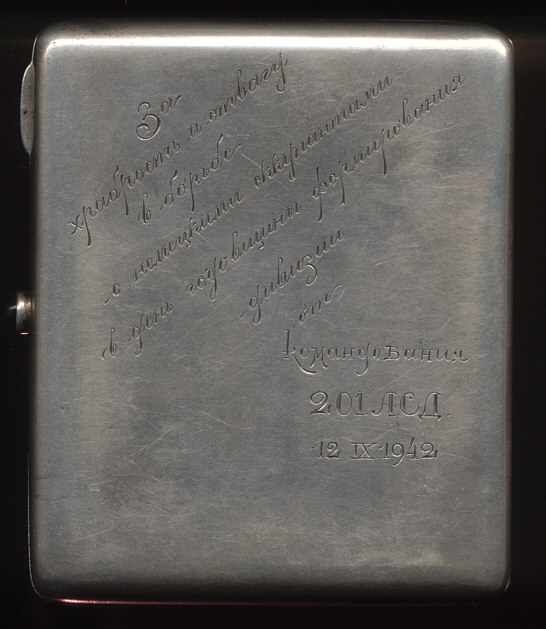
 0
0 -
I have just heard from my research magician that it may, in some cases, now be possible to research Soviet Afghan War awards. FYI.
Is this new? I haven't researched any Afghan War awards (though I'd like to!) but I have been able to get research on awards from that time frame. Digger Doug has a nice set that meets that criteria...
http://gmic.co.uk/index.php?showtopic=2940
Dave
0 -
which begats an interesting side-bar question. There's so many "period repaired" pieces floating around. It must have been quite an industry. How much is value/desireability affected by these repairs?
I think much of that is personal preference. First, it's tough to tell whether something was repaired by the vet or by a collector. I once bought a group (and have since sold it) where two of the awards were screwbacks that had been converted by the vet to hanging. A collector had attempted to re-convert them back to screwback, but instead ended up drilling big divots in the back of the medals before giving up and selling the group. I got the group, took the awards to my family jeweler who then added a 14K gold loop to one and a sterling silver loop to the other (so they were the right matching materials). In this case, the awards had been "messed with" by two collectors and the vet himself.
Broken enamel was pretty common on Soviet awards. Figure that many of them were worn in combat and were just not treated all that well. I've dropped my fair share of awards (two) and have seen the enamel break out of them... just imagine all the awards that were dropped over time by either their owners, or the kids playing with them, etc.... I was visiting one family in Russia and they pulled out their grandfather's awards, which included a Lenin. The group was nicely mounted, except for the Lenin that was just loose in the box and getting pretty beat up from randomly hitting the other medals as the box was moved around. Go figure.
I haven't seen too many good enamel repair jobs come out of Russia, though I do know of at least one US-based dealer that has a contact that can make "near" perfect repairs of the enamel - so good, in fact, that the repairs pass most collector's inspections of the repaired pieces.
As far as desireability, going back to the top of this post, I think it's mostly just personal preference. I like awards with some "wear" to them. To me, it adds character. I love getting groups with awards that have damaged pieces and a photo of the vet wearing that exact damaged piece. That just goes to even further the connection with the vet in my opinion.
To many collectors though, they want their awards "perfect". Those are the same ones that give Rick R. a bit of heartburn as they're normally the ones that buy a group because of the "rare perfect condition version of X" award, and can care less about the WHY of the group. I even once sold a group to a guy and not a few weeks later saw all of the vet's other awards and documents up on eBay as the collector only wanted the single "rare" example of a certain award in the group! (Luckily, I was able to convince him to keep the group together, but how many more are like that out there???)
Perfect condition awards will always bring a premium, but at the same time, you need to determine why you're collecting... for condition or history? Sometimes they go hand in hand, but many other times that's not the case.
My two cents...
Dave
0 -
Unfortunately his personnel records were not, apparently, available
Or... were... perhaps... not requested by the sinister peoples...

ooooooops.

Well. Still a pretty cool citation! My contribution to the whole Sivash crossing was also another downgrade. It's action took place a couple days apart from Agiton's.
Pretty neat stuff! That must have been one helluva crossing!
Dave
0 -
Same print date as the previous one, but with a lower number and lower date... I wonder if you could pretty much count on these being consecutively issued???
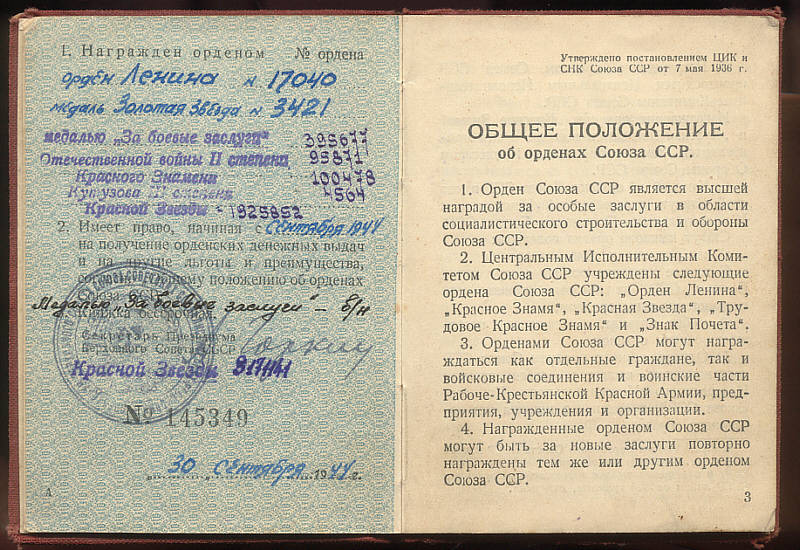
 0
0 -
And the inside. Let me know if you'd like a scan of the page with the 1943 print date...
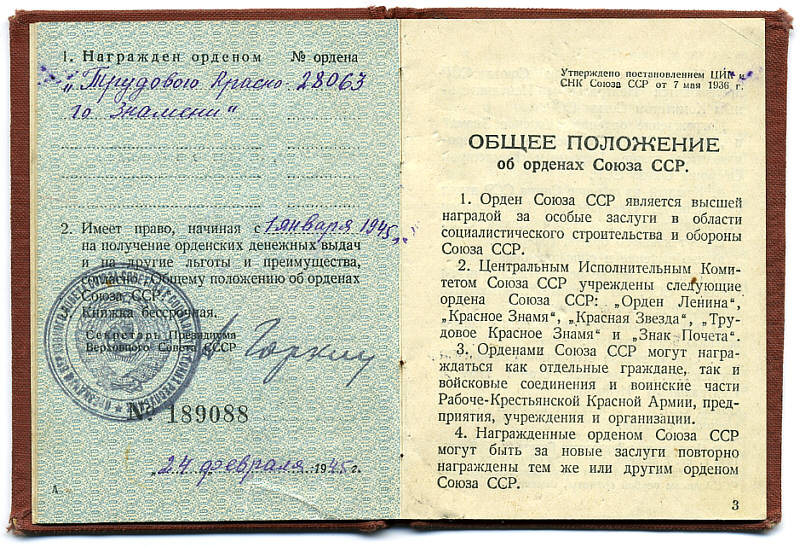
 0
0




Complete Cased Soviet Group
in Russia: Soviet Orders, Medals & Decorations
Posted
Ask and thou shalt receive...
This is a photo of MG Emil Reinhardt, CG of the 69th Division, wearing is Suvorov 2nd Class. I have a few of these photos going into my article for JOMSA. I was actually just at a funeral today for a recipient of the Order of Nevsky and his family found a nice photo of him wearing it. I'm trying to get a scan of that from them.
Dave